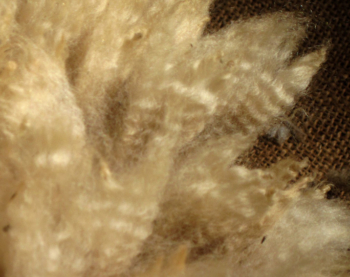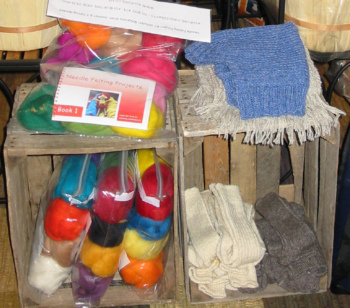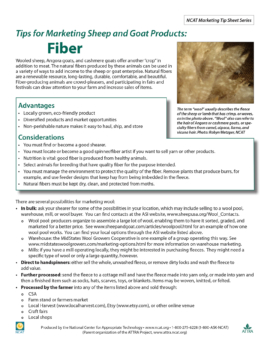Tips for Marketing Sheep and Goat Products: Fiber

The term “wool” usually describes the fleece of the sheep or lamb that has crimp, or waves, as in the photo above. “Wool” also can refer to the hair of Angora or cashmere goats, or specialty fibers from camel, alpaca, llama, and vicuna hair. Photo: Robyn Metzger, NCAT
NCAT Marketing Tipsheet Series
By Margo Hale and Linda Coffey, NCAT Agriculture Specialists
Wooled sheep, Angora goats, and cashmere goats offer another “crop” in addition to meat. The natural fibers produced by these animals can be used in a variety of ways to add income to the sheep or goat enterprise. Natural fibers are a renewable resource, long-lasting, durable, comfortable, and beautiful. Fiber-producing animals are crowd-pleasers, and participating in fairs and festivals can draw attention to your farm and increase sales of items.
Advantages
- Locally grown, eco-friendly product
- Diversified products and market opportunities
- Non-perishable nature makes it easy to haul, ship, and store
Considerations
- You must find or become a good shearer.
- You must locate or become a good spinner/fiber artist if you want to sell yarn or other products.
- Nutrition is vital: good fiber is produced from healthy animals.
Select animals for breeding that have quality fiber for the purpose intended.- You must manage the environment to protect the quality of the fiber. Remove plants that produce burrs, fornexample, and use feeder designs that keep hay from being imbedded in the fleece.
- Natural fibers must be kept dry, clean, and protected from moths.
There are several possibilities for marketing wool:
- In bulk: ask your shearer for some of the possibilities in your location, which may include selling to a wool pool, warehouse, mill, or wool buyer. You can find contacts at the ASI website.
—Wool pool: producers organize to assemble a large lot of wool, enabling them to have it sorted, graded, and marketed for a better price. See for an example of how one wool pool works. You can find your local options through the ASI website.
—Mills: if you have a mill operating locally, they might be interested in purchasing fleeces. They might need a specific type of wool or only a large quantity, however. - Direct to handspinners: either sell the whole, unwashed fleece, or remove dirty locks and wash the fleece to add value.
- Further processed: send the fleece to a cottage mill and have the fleece made into yarn only, or made into yarn and then a finished item such as socks, hats, scarves, toys, or blankets. Items may be woven, knitted, or felted.
- Processed by the farmer into any of the items listed above and sold through:
—CSA
—Farm stand or farmers market
—Local Harvest, Etsy, or other online venue
—Craft fairs
—Local shops

Photo: Margo Hale, NCAT
Tips for Marketing Fiber
- Learn about fiber and about what your customers want. Characteristics important to customers may include fineness, strength, color, cleanliness, and staple length.
- Skirt fleeces well. This means to remove any dirty locks from the edges.
- Market the fiber with energy and enthusiasm. Your animals have produced a locally-grown, natural resource that will appeal to modern-day consumers who want eco-friendly fibers.
- Sell not only the item but also lessons in spinning, knitting, and felting.
You can find potential customers in many places:
- Join a spinning or knitting guild
- Take classes at a yarn shop
- Contact groups involved in historical reenactment; socks, hats, and blankets will be in demand
- Investigate state park gift shops to see if they would offer natural fiber products
- Participate in fiber festivals
- Network with hikers or runners who value natural-fiber socks and hats
- Participate in local foods groups to meet people who value locally-grown products
- Consider your state programs for locally-grown produce and list your farm and products
- Visit “natural baby” stores to offer natural fiber items useful for small children
- Market blankets as wedding or baby gifts, or as gifts to college students in school colors
- Market wool socks to those who work outdoors and to the elderly
Resources
ATTRA – National Sustainable Agriculture Information Service
Sheep Shearing Directory
Click on your state to find contact information for a professional sheep shearer.
The Fleece & Fiber Sourcebook. 2012. Carol Ekarius and Deborah Robson. Storey Publishing. 448 p.
This book is a great place to learn about fiber and to categorize the uses of fiber produced by particular breeds. It includes almost every sheep breed in the world, as well as goats, alpacas, llamas, vicunas, and more unusual fiber animals such as horses, bison, musk oxen, rabbits, and dogs.
Turning Wool Into a Cottage Industry. 1991. Paula Simmons. Storey Publishing. 188 p.
A classic guide to beginning a fiber business, packed with information. This book covers a wealth of material and is written from the author’s own experience, as well as that of many other farmers and entrepreneurs.
Tips for Marketing Sheep and Goat Products: Fiber
© 2012 National Center for Appropriate Technology—NCAT
By Margo Hale and Linda Coffey, NCAT
IP397
This publication is produced by the National Center for Appropriate Technology through the ATTRA Sustainable Agriculture program, under a cooperative agreement with USDA Rural Development. This publication was also made possible in part by funding from USDA/NIFA/OASDFR. ATTRA.NCAT.ORG.


